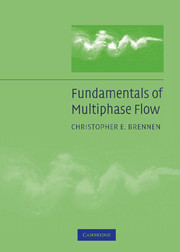Book contents
- Frontmatter
- Contents
- Preface
- Nomenclature
- 1 Introduction to Multiphase Flow
- 2 Single-Particle Motion
- 3 Bubble or Droplet Translation
- 4 Bubble Growth and Collapse
- 5 Cavitation
- 6 Boiling and Condensation
- 7 Flow Patterns
- 8 Internal Flow Energy Conversion
- 9 Homogeneous Flows
- 10 Flows with Bubble Dynamics
- 11 Flows with Gas Dynamics
- 12 Sprays
- 13 Granular Flows
- 14 Drift Flux Models
- 15 System Instabilities
- 16 Kinematic Waves
- Bibliography
- Index
12 - Sprays
Published online by Cambridge University Press: 05 June 2014
- Frontmatter
- Contents
- Preface
- Nomenclature
- 1 Introduction to Multiphase Flow
- 2 Single-Particle Motion
- 3 Bubble or Droplet Translation
- 4 Bubble Growth and Collapse
- 5 Cavitation
- 6 Boiling and Condensation
- 7 Flow Patterns
- 8 Internal Flow Energy Conversion
- 9 Homogeneous Flows
- 10 Flows with Bubble Dynamics
- 11 Flows with Gas Dynamics
- 12 Sprays
- 13 Granular Flows
- 14 Drift Flux Models
- 15 System Instabilities
- 16 Kinematic Waves
- Bibliography
- Index
Summary
Introduction
Sprays are an important constituent of many natural and technological processes and range in scale from the very large dimensions of the global air/sea interaction and the dynamics of spillways and plunge pools to the smaller dimensions of fuel injection and ink-jet systems. In this chapter we first examine the processes by which sprays are formed and some of the resulting features of those sprays. Then, because the combustion of liquid fuels in droplet form constitute such an important component of our industrialized society, we focus on the evaporation and combustion of single droplets and follow that with an examination of the features involved in the combustion of sprays.
Types of Spray Formation
In general, sprays are formed when the interface between a liquid and a gas becomes deformed and droplets of liquid are generated. These then migrate out into the body of the gas. Sometimes the gas plays a negligible role in the kinematics and dynamics of the droplet formation process; this simplifies the analyses of the phenomena. In other circumstances the gas dynamic forces generated can play an important role. This tends to occur when the relative velocity between the gas and the liquid becomes large as is the case, for example, with hurricane-generated ocean spray.
Several prototypical flow geometries are characteristic of the natural and technological circumstances in which spray formation is important. The first prototypical geometry is the flow of a gas over a liquid surface.
- Type
- Chapter
- Information
- Fundamentals of Multiphase Flow , pp. 232 - 251Publisher: Cambridge University PressPrint publication year: 2005

